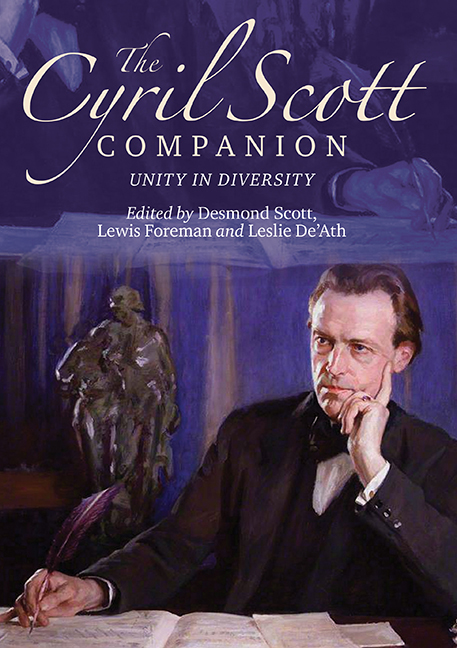Book contents
- Frontmatter
- Dedication
- Contents
- List of Illustrations
- List of Tables
- List of Contributors
- Foreword
- Preface
- Acknowledgements
- Editors' Note
- I SCOTT IN CONTEXT
- II THE MUSIC
- 8 Discovering, Editing and Recording Cyril Scott
- 9 ‘Years of Indiscretion’: The Early Piano Works, 1898–1909
- 10 ‘Like a Bird Sings’: The Piano Works from the Op. 66 Sonata to World War 1
- 11 The Later Piano Works
- 12 The Twenty-First-Century Orchestral Recordings: The Shock of the Unknown
- 13 The Chamber Music
- 14 Operas and Music for the Theatre
- 15 The Choral Works
- 16 The Songs
- III THE WRITINGS
- IV PERSONAL REMINISCENCES
- APPENDICES
- CATALOGUES, DISCOGRAPHY AND BIBLIOGRAPHY
- Index of Works
- General Index
10 - ‘Like a Bird Sings’: The Piano Works from the Op. 66 Sonata to World War 1
from II - THE MUSIC
Published online by Cambridge University Press: 14 September 2019
- Frontmatter
- Dedication
- Contents
- List of Illustrations
- List of Tables
- List of Contributors
- Foreword
- Preface
- Acknowledgements
- Editors' Note
- I SCOTT IN CONTEXT
- II THE MUSIC
- 8 Discovering, Editing and Recording Cyril Scott
- 9 ‘Years of Indiscretion’: The Early Piano Works, 1898–1909
- 10 ‘Like a Bird Sings’: The Piano Works from the Op. 66 Sonata to World War 1
- 11 The Later Piano Works
- 12 The Twenty-First-Century Orchestral Recordings: The Shock of the Unknown
- 13 The Chamber Music
- 14 Operas and Music for the Theatre
- 15 The Choral Works
- 16 The Songs
- III THE WRITINGS
- IV PERSONAL REMINISCENCES
- APPENDICES
- CATALOGUES, DISCOGRAPHY AND BIBLIOGRAPHY
- Index of Works
- General Index
Summary
The best traveller has no fixed plans, and is not intent on arriving.
(Lao Tzu)IT is perhaps fitting that a sentiment expressed by a legendary figure from a distant past, outside the Western tradition, should encapsulate Scott's approach to musical creation, for he was a composer who embraced many different traditions of thought in the formulation of his own aesthetic. If the opening of Beethoven's Fifth Symphony is the iconic example of an entire work emanating inexorably from a pithy nuclear motif, Scott's music often meanders disarmingly, apparently unconcerned with path or quest. This was a defining feature of his writing in connection with works as early as the Sonata in D, Op. 17, and the Scherzo, Op. 20. His method was empirical and sensuous rather than orderly and cerebral. Grainger put it most poetically when he remarked that Scott composes ‘rather like a bird sings’: unpredictable in detail and order, while unified in aesthetic concept. This perhaps also explains why Scott's large quantity of music for piano resists categorisation. Attempts to order his entire piano output into a small number of compositional ‘types’ invariably founder, faced with some works that seem to straddle two or more categories, and others that fit nowhere.
Stravinsky may have abhorred what he called the ‘abyss of freedom’, but Scott's music plays itself out and thrives on a loose harmonic, rhythmic and metric framework, in which the listener often has no idea what the next bar will bring. Composing to a rigid framework disenfranchises him. Schönberg, Scriabin and Hindemith may have found composing according to a system the ideal stimulus for the imagination, but Scott's imagination was fired by what he came to call ‘musical flow’. This operates both on the larger and smaller design levels, but does not prevent him from employing standard musical forms such as sonata, ternary form, fugue, and passacaglia, at least nominally. Such flow forms the underlying basis of the two most ambitious and lengthy works for solo piano in his entire output, the first known as Sonata No. 1, Op. 66 (written in the summer of 1908 at Shere), and the second as Deuxieme suite (published 1910). Although this chapter covers a mere ten years, several of Scott's most significant works for piano were written therein.
- Type
- Chapter
- Information
- The Cyril Scott CompanionUnity in Diversity, pp. 143 - 160Publisher: Boydell & BrewerPrint publication year: 2018



